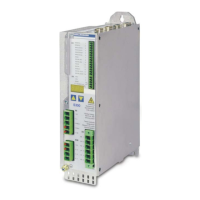6.10 Shock-hazard protection
6.10.1 Leakage current
Leakage current via the PE conductor results from the combination of equipment and
cable leakage currents. The leakage current frequency pattern comprises a number of
frequencies, whereby the residual-current circuit breakers definitively evaluate the 50Hz
current. As a rule of thumb, the following assumption can be made for leakage current on
our low-capacity cables at a mains voltage of 400 V, depending on the clock frequency of
the output stage:
I
leak
= n x 20mA + L x 1mA/m at 8kHz clock frequency at the output stage
I
leak
= n x 20mA + L x 2mA/m at a 16kHz clock frequency at the output stage
(where Ileak=leakage current, n=number of amplifiers, L=length of motor cable)
At other mains voltage ratings, the leakage current varies in proportion to the voltage.
Example: 2 x servo amplifiers + a 25m motor cable at a clock frequency of 8kHz:
2 x 20mA + 25m x 1mA/m = 65mA leakage current.
Since the leakage current to PE is more than 3.5 mA, in compliance with
IEC 61800-5-1 the PE connection must either be doubled or a connecting cable with a
cross-section >10mm² must be used. Use the PE terminals and the PE bolt in order to ful-
fil this requirement.
The following measures can be used to minimise leakage currents.
— Reduce the length of the engine cable
— Use low-capacity cables (see p.53)
— Remove external EMC filters (radio-interference suppressors are integrated)
6.10.2 Residual current protective device (RCD)
In conformity with IEC 60364-4-41 – Regulations for installation and IEC 60204 – Electri-
cal equipment of machinery, residual current protective devices (called RCD below) can
be used provided the requisite regulations are complied with. The S300 is a 3-phase sys-
tem with a B6 bridge. Therefore, RCDs which are sensitive to all currents must be
used in order to detect any D.C. fault current.
Rated residual currents in the RCD
10 -30 mA
Protection against "indirect contact" for stationary and mobile equipment,
as well as for "direct contact".
50 -300 mA
Protection against "indirect contact" for stationary equipment
Recommendation: In order to protect against direct contact (with motor cables shorter
than 5 m) we recommend that each servo amplifier be protected individually using a
30mA RCD which is sensitive to all currents.
If you use a selective RCD, the more intelligent evaluation process will prevent spurious
tripping of the RCD.
6.10.3 Isolating transformers
When protection against indirect contact is absolutely essential despite a higher leakage
current, or when an alternative form of shock-hazard protection is sought, the S300 can
also be operated via an isolating transformer (schematic connection see p.58). A
ground-leakage monitor can be used to monitor for short circuits.
Be advised to keep the length of wiring between the transformer and the servo amplifier
as short as possible.
44 S300 Instructions Manual
Technical description 02/2017 Kollmorgen

